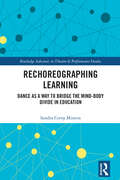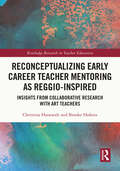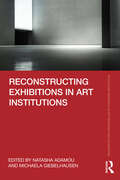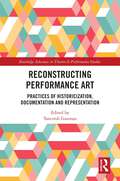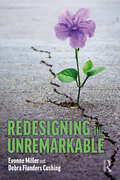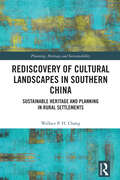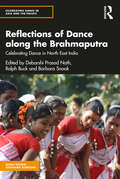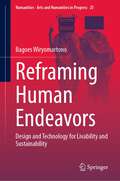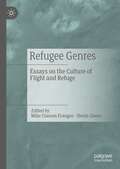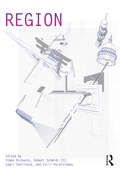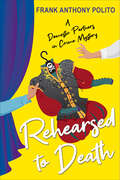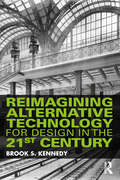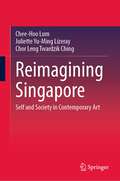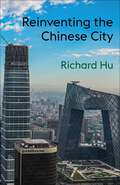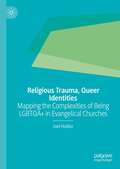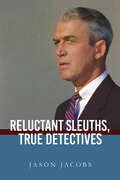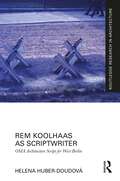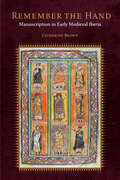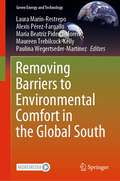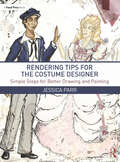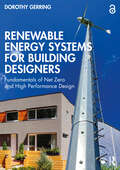- Table View
- List View
Rechoreographing Learning: Dance As a Way to Bridge the Mind-Body Divide in Education (Routledge Advances in Theatre & Performance Studies)
by Sandra Cerny MintonThis book addresses the mind-body dichotomy in movement and dance. This book includes a description of the often-forgotten kinesthetic sense, body awareness, somatic practices, body-based way of thinking, mental imagery, nonverbal communication, human empathy, and symbol systems, what occurs in the brain during learning, and why and how movement and dance should be part of school curricula. This exploration arguers that becoming more aware of bodily sensations serves as a basis for knowing, communicating, learning, and teaching through movement and dance. This book will be of great interest to scholars and students interested in teaching methodology and for courses in physical education, dance, and education.
Reconceptualizing Early Career Teacher Mentoring as Reggio-Inspired: Insights from Collaborative Research with Art Teachers (Routledge Research in Teacher Education)
by Christina Hanawalt Brooke HofsessReconceptualizing Early Career Teacher Mentoring as Reggio-Inspired presents an innovative approach to early career art teacher mentoring informed by both the philosophy of Reggio Emilia and an ontology of immanence while simultaneously illuminating the experiences of the teacher-participants as co-inquirers within the contemporary milieu of public education in the United States. Readers are invited to travel with a group of teacher educators and early career PK-12 art teachers across a four-year journey to experience the evolving nature of a collaborative inquiry through mentoring-as-research, the Teacher Inquiry Group (TIG). The authors share significant insights regarding what it means to be an early career art teacher––especially in an educational climate steeped in neoliberal agendas, standardization, and accountability––and make potent suggestions for re-visioning entrenched approaches to mentoring and professional learning that better account for the inherent complexities of teaching in schools. Advocating for more complex understandings regarding teacher subjectivity and the contextual forces at work in schools, the authors provoke an expanded vision of how mentoring can be imagined, practiced, and lived in current educational contexts. The authors employ key orientations grounded in the Reggio Emilia philosophy to reimagine an under-researched and undertheorized area of study in art education-––early career teacher mentoring––that has implications for teachers at all levels and across all disciplines. This volume is essential reading for scholars and professionals across the fields of art education, teacher preparation, teacher education, and mentoring. It will appeal to educational researchers, K-12 practitioners, teacher educators, and administrators working with new teachers, as well as those interested in mentoring, Reggio Emilia, professional learning and development, art and aesthetic education, and emergent, process-oriented research methodologies.
Reconceptualizing Early Career Teacher Mentoring as Reggio-Inspired: Insights from Collaborative Research with Art Teachers (Routledge Research in Teacher Education)
by Christina Hanawalt Brooke HofsessReconceptualizing Early Career Teacher Mentoring as Reggio-Inspired presents an innovative approach to early career art teacher mentoring informed by both the philosophy of Reggio Emilia and an ontology of immanence while simultaneously illuminating the experiences of the teacher-participants as co-inquirers within the contemporary milieu of public education in the United States.Readers are invited to travel with a group of teacher educators and early career PK-12 art teachers across a four-year journey to experience the evolving nature of a collaborative inquiry through mentoring-as-research, the Teacher Inquiry Group (TIG). The authors share significant insights regarding what it means to be an early career art teacher––especially in an educational climate steeped in neoliberal agendas, standardization, and accountability––and make potent suggestions for re-visioning entrenched approaches to mentoring and professional learning that better account for the inherent complexities of teaching in schools. Advocating for more complex understandings regarding teacher subjectivity and the contextual forces at work in schools, the authors provoke an expanded vision of how mentoring can be imagined, practiced, and lived in current educational contexts. The authors employ key orientations grounded in the Reggio Emilia philosophy to reimagine an under-researched and undertheorized area of study in art education-––early career teacher mentoring––that has implications for teachers at all levels and across all disciplines. This volume is essential reading for scholars and professionals across the fields of art education, teacher preparation, teacher education, and mentoring. It will appeal to educational researchers, K-12 practitioners, teacher educators, and administrators working with new teachers, as well as those interested in mentoring, Reggio Emilia, professional learning and development, art and aesthetic education, and emergent, process-oriented research methodologies.
Reconstructing Exhibitions in Art Institutions (Routledge Research in Art Museums and Exhibitions)
by Natasha Adamou Michaela GiebelhausenReconstructing Exhibitions in Art Institutions spans exhibition histories as anti-apartheid activism within South African community arts; collectivities and trade unions in Argentina; Civil Rights movements and Black communities in Baltimore; institutional self-critique within the neoliberal museum; reframing feminisms in USA; and revisiting Cold War Modernisms in Eastern Europe among other themes. An interdisciplinary project with a global reach, this edited volume considers the theme of exhibitions as political resistance as well as cultural critique from global perspectives including South Africa, Latin America, Eastern Europe, USA and West Europe. The book includes contributions by ten authors from the fields of art history, social sciences, anthropology, museum studies, provenance research, curating and exhibition histories. The edited volume finally examines exhibition reconstructions both as a symptom of advanced capitalism, geopolitical dynamics and social uprisings, and as a critique of imperial and capitalist violence. Art historical areas covered in the book include conceptualism, minimalism, modern painting, global modernisms, archives and community arts. This volume will be of interest to a wide range of audiences including art historians, curators, gallery studies and museum professionals, and also to scholars and students from the fields of anthropology, ethnography, sociology, and history. It would also appeal to a general public with an interest in modern and contemporary art exhibitions.
Reconstructing Performance Art: Practices of Historicisation, Documentation and Representation (Routledge Advances in Theatre & Performance Studies)
by Tancredi GusmanThis book investigates the practices of reconstructing and representing performance art and their power to shape this art form and our understanding of it. Performance art emerged internationally between the 1960s and 1970s crossing disciplinary boundaries between performing arts and visual arts. Because of the challenge it posed to the ontologies and paradigms of these fields, performance art has since stimulated an ongoing debate on the most appropriate means to document, preserve and display it. Tancredi Gusman brings together international scholars from different disciplinary fields to examine methods, media, and approaches by which this art form has been represented and (re)activated over time and its transnational history reconstructed. Through contributions and case studies spanning various countries, regions and artistic fields, the authors outline an innovative theoretical-methodological framework for capturing the processes and strategies for transmitting the tangible and intangible heritage of performance art. This book will be of great appeal to students, researchers, and practitioners in the fields of Theatre and Performance Studies as well as Visual Arts and Art History, who have an interest in performance art, its history and presence in the contemporary artistic and cultural landscape.
Redesigning the Unremarkable
by Debra Flanders Cushing Evonne MillerRedesigning the Unremarkable is a timely and necessary reminder that the often neglected elements and spaces of our built environment – from trash bins, seats, stairways, and fences to streets, bikeways, underpasses, parking lots, and shopping centres – must be thoughtfully redesigned to enhance human and planetary health. Using the lens of sustainable, salutogenic, and playable design, in this inspiring book, Miller and Cushing explore the challenges, opportunities, and importance of redesigning the unremarkable. Drawing on global research, theory, practical case studies, photographs, and personal experiences, Redesigning the Unremarkable is a vital text – a doer’s guide – for researchers, policymakers, and practitioners wanting to transform and positively reimagine our urban environment.
Rediscovery of Cultural Landscapes in Southern China: Sustainable Heritage and Planning in Rural Settlements (Planning, Heritage and Sustainability)
by Wallace P.H. ChangThis book investigates the concept of human landscape in rural settlements in Southern China, where communities and their cultural landscapes are facing contemporary challenges following a period of rapid urbanization in the last 50 years. While metropolitan cities, such as Hong Kong, are experiencing accelerated urban development, underpopulated rural villages are struggling to maintain the cultural heritage of their regions. Rediscovery of Cultural Landscapes in Southern China provides a detailed account into indigenous living cultures in traditional, rural settlements upon natural landscapes. Beginning with an overview of the theoretical framework, the book presents six unique cases, including: Tai O, Yim Tin Tsai, Lai Chi Wo, Nga Tsin Wai, Cangdong, and Meinong, while illustrating a relevant comparison between Hakka and Satoyama landscape systems. The spectrum of theoretical and case analyses allows for a rethinking of the evolving cultural landscape’s positioning with valuable heritages in the context of a post-industrial society. The book is written towards reinterpreting the cultural landscape by conceptualizing the human landscape for scholars, practitioners, and students interested in rural-cultural conservation and revitalization, heritage management, traditional architecture and landscape planning, and urban-rural development.
Reflections of Dance along the Brahmaputra: Celebrating Dance in North East India (Celebrating Dance in Asia and the Pacific)
by Debarshi Prasad Nath, Ralph Buck, and Barbara SnookThis volume brings a critical lens to dance and culture within North East India. Through case studies, first-hand accounts, and interviews, it explores unique folk dances of Indigenous communities of North East India that reflect diverse journeys, lifestyles, and connections within their ethnic groups, marking almost every ritual and festival. Dance for people of North East India, as elsewhere, is also a way of declaring, establishing, celebrating, and asserting humans' relationship with nature. The book draws attention to the origins and special circumstances of dances from North East India. It discusses a range of important folk-dance forms alongside classical dance forms in North East India, with a focus on Sattriya dance. The chapters examine how these dance forms play an important role in the region’s socio-cultural, economic, and political life, intertwining religion and the arts through music, dance, and drama. Further, they also explore how folk dance cultures in North East India have never been relegated to the background, never considered secondary, aesthetically, or otherwise, but have become expressions of political and cultural identity. An evocative work, this volume will be of interest to students and researchers of pedagogy, choreography, community dance practice, theatre and performance studies, social and cultural studies, aesthetics, interdisciplinary arts, and more. It will be an invaluable resource for artists and practitioners working in dance schools and communities.
Reframing Human Endeavors: Design and Technology for Livability and Sustainability (Numanities - Arts and Humanities in Progress #25)
by Bagoes WiryomartonoThis ambitious text is a monograph about human experiences concerning the potentialities, capacities, and features of humankind from the wholeness of the collective mind body spirit. The purpose in reframing human endeavors is for enhanced alignment for livability and sustainability. This book departs from the concept and practice of “design and technology” and argues that most crises that endanger and destruct our ecological livability and sustainability come from our way of thinking and doing with “design and technology” based on the necessity for control. It is the control for overcoming the fear of scarcity, starvation, and the unknown. This book is rather an attempt to find alternate way of decision-making thru holistic methods. It appeals to researchers working in design, sustainability, architecture and urban studies.
Refugee Genres: Essays on the Culture of Flight and Refuge
by Mike Classon Frangos Sheila GhoseThis volume brings together research on the forms, genres, media and histories of refugee migration. Chapters come from a range of disciplines and interdisciplinary approaches, including literature, film studies, performance studies and postcolonial studies. The goal is to bring together chapters that use the perspectives of the arts and humanities to study representations of refugee migration. The chapters of the anthology are organized around specific forms and genres: life-writing and memoir, the graphic novel, theater and music, film and documentary, coming-of-age stories, street literature, and the literary novel.
Region (Critiques Ser.)
by Simon Richards Robert Schmidt III Cagri Sanliturk Falli PalaiologouThis book explores how the concept of ‘region’ has evolved over time and shaped architectural culture and practice. It questions what the words ‘region’ and ‘regional’ mean for architecture, cities and landscapes past and present, and speculates on the forms they might take in the future. Region is explored in many thematic guises: as a real geographical site of evolving socio-economic activity; as a mythical locus of enduring value; as a gatekeeper of indigenous crafts and vernacular techniques; as a site of architectural and artistic imagination; as a repository of contested, conflicted and mobile identities. The contributing chapters take these themes from the theoretical and literary page through to architectural and urban practice, and from the scale of the domestic hearth through to the ocean archipelago and international law, enriching the long-standing trope of viewing architectural regionalism purely as a matter of style. Curated into four key thematic areas – Theorised Regions, Contested Regions, Heritage Regions and Future Regions – the book incorporates the values, concerns and approaches of a truly diverse international community of scholars, curators and practitioners, as well as the design work of international students tasked to explore what region means to them.
Rehearsed to Death (A Domestic Partners in Crime Mystery #2)
by Frank Anthony PolitoAward-winning author and playwright Frank Anthony Polito continues his debut cozy mystery series featuring a gay couple who solve crimes while renovating houses as part of their hit reality show Domestic Partners. Set in suburban Detroit, it's Hart to Hart via HGTV! The perfect combination for fans of home repair and cozy mysteries. Peter&’s first play is having its world premiere at Pleasant Woods&’s community theater. His handsome one and only, JP, has the lead. Rehearsals have begun. And New York City&’s award-winning, hotshot helmer, Xander Sherwood Deva, is directing. Unfortunately the controlling, arrogant, poison-barbed, egomaniacal diva has everyone on edge. No wonder he finallypushes someone over it . . . Xander is found strangled to death in the same extra-long, imported cashmere scarf he&’s been brandishing like a boa ever since he arrived. In the name of making art he&’s burned a lot of bridges and made a lot of enemies but which one wanted to bring down the curtain on him? As they say in the theater: the show must go on. But not before amateur sleuths Peter and JP become Domestic Partners in Crime and try to solve this deadly real-life drama ahead of opening night. Praise for Renovated to Death &“Quirky [and] humorous.&” —Kirkus Reviews &“A fast, fun read—with bonus renovating tips!&”--Laura Levine, author of Death by Smoothie
Reimag(in)ing the Victorians in Contemporary Art: Britain and Beyond
by Isobel ElstobFrom contemporary deployments of taxidermy, magic lanterns and microscopy to the visualization of forgotten lives, marginalized narratives and colonial histories, this book explores how the work of artists including Mat Collishaw, Yinka Shonibare, Tessa Farmer, Mark Dion, Dorothy Cross and Ingrid Pollard reimag(in)es the Victorians in the ‘present’. Examining how recent paintings, sculptures, photographs, installations and films revisit and re-present nineteenth-century technologies, practices and events, the book’s rich interdisciplinary approach applies literary, media and linguistic theories to its analysis of visual art, alongside in-depth discussions of the Victorian inventions, concepts and narratives that they invoke. The book’s emphasis on how – and why – we represent the historical past makes its contribution particularly timely. And by drawing attention to the importance of historiography to the work of these artists, it also unravels the complicated history of History itself. This book will speak to diverse audiences including those interested in art history, visual culture, Victorian and neo-Victorian studies, as well as literature, histories of science and media, postcolonialism, museology, gender studies, postmodernism and the history of ideas.
Reimagining Alternative Technology for Design in the 21st Century
by Brook S. KennedyReimagining Alternative Technology for Design in the 21st Century presents a new approach to design that harnesses still-valuable alternative, traditional and abandoned technologies alongside the creation of new ones to address contemporary global problems. It focuses on design opportunities that reduce energy and material consumption to tackle issues such as climate change and pollution in industrialized economies. The book takes the reader on a journey surveying different facets of human activity to identify underused and discarded technologies that could be indispensable today. It critically addresses newer approaches to design and technology by comparing them to existing alternatives, unpacking examples including air conditioning with smart thermostats, electric lighting, durable reusable products, domestic maintenance tools and methods of transportation. Written for practicing designers and students in industrial design, architecture, sustainable design and human-centered design, this book provides new ideas and tools for creating more useful, energy-and-resource-efficient product designs and systems.
Reimagining Singapore: Self and Society in Contemporary Art
by Chee-Hoo Lum Juliette Yu-Ming Lizeray Chor Leng Twardzik ChingThis book approaches the subject of contemporary art by exploring the social embeddedness and identities of Singaporean artists. Linking artistic processes and production to both personal worlds and wider issues, the book examines how artists negotiate their relationships between self and society and between artistic freedom and social responsibility. It is based on original research into the discourses and artistic practices of local artists, with a special focus on emerging artists and artists whose work and perspectives engage with questions of identity. Reimagining contemporary Singapore and their place within it, artists are asserting their multiple and heterogeneous self-identities and contesting hegemonic norms and notions, as they negotiate and adapt to the world around them. This book is relevant to students and researchers in the fields of cultural studies, media studies, art, sociology of art, arts education, and race and ethnicity studies.
Reinventing the Chinese City
by Richard HuSince the late 1970s, China has undergone perhaps the most sweeping process of urbanization ever witnessed. This is typically understood as a story of growth, encompassing rapid development and economic dynamism alongside environmental degradation and social dislocation. However, over the past decade, China’s leaders have claimed that the country’s urbanization has entered a new stage that prioritizes “quality.” What does China’s new urban vision entail, and what does the future hold in store?Richard Hu unpacks recent trends in urban planning and development to explore the making and imagining of the contemporary Chinese city. He focuses on three key concepts—the “green revolution,” “smart city movement,” and “great innovation leap forward”—that have become increasingly influential. Through case studies of Beijing, Hangzhou, and Hefei, Hu analyzes how attempts to achieve greater sustainability, promote data-driven governance, and foster innovation have fared on the ground. He also considers the experimental city Xiong’an in terms of China’s idealized vision of the urban future and investigates how the recent experiences of Hong Kong relate to regional and national development projects.Reinventing the Chinese City provides a careful accounting of the ideas that have dominated urban policy in China since 2010, emphasizing key continuities underlying claims of novelty. Shedding light on the transformations of the Chinese city, this book offers a new perspective on the factors that will shape the trajectory of urbanization in the coming decades.
Religion and Contemporary Art: A Curious Accord
by Ronald R. BernierReligion and Contemporary Art sets the theoretical frameworks and interpretive strategies for exploring the re-emergence of religion in the making, exhibiting, and discussion of contemporary art. Featuring essays from both established and emerging scholars, critics, and artists, the book reflects on what might be termed an "accord" between contemporary art and religion. It explores the common strategies contemporary artists employ in the interface between religion and contemporary art practice. It also includes case studies to provide more in-depth treatments of specific artists grappling with themes such as ritual, abstraction, mythology, the body, popular culture, science, liturgy, and social justice, among other themes. It is a must-read resource for working artists, critics, and scholars in this field, and an invitation to new voices "curious" about its promises and possibilities.
Religion and the American West: Belief, Violence, and Resilience from 1800 to Today
by Jessica Lauren NelsonReligion and the American West offers a lavishly illustrated and comprehensive overview of the ways religion has shaped the idea of the American West and how the region has influenced broader religious and racial categories. Starting when the concept of the &“American West&” emerged in the early 1800s and continuing the analysis through modern times, Religion and the American West explores the interplay between a wide range of American belief systems, from established world religions to new spiritual innovations.A stunning selection of material and print culture illustrates the varied range of religious expressions across the history of the American West. Taken as a whole, the contributors challenge longstanding definitions of the American West and provide a new narrative that recenters our attention on the lived experiences of diverse peoples and communities. It also serves as the companion publication for the exhibition &“Acts of Faith,&” opening fall 2023 at the New York Historical Society. Religion and the American West is a story of vibrant innovation and tragic conflict, showcasing how historical actors and modern-day readers wrestle with the meaning of religious belief in the American West.
Religious Trauma, Queer Identities: Mapping the Complexities of Being LGBTQA+ in Evangelical Churches
by Joel HollierIn a polarised milieu that too often posits “queer” and “Christian” as competing realms, this book explores the complexities of identity development, religious traumatisation, and the task of creating safe faith spaces in which LGBTQA+ people can find healing, particularly in the Evangelical context. First, Joel Hollier examines the historical path of Evangelicalism, providing context for the current terrain of the “culture war” we find ourselves in. He then parses out experiences of gender/sexuality and religious/spiritual identity development, grounding them in an evolving theoretical base. Finally, Hollier offers a rounded critique of Evangelical church structures and mechanisms of trauma that hinder the healing process, along with potential sources of healing. Central to this work are the voices of LGBTQA+ people whose stories weave together a deeper understanding of the harms the Church has perpetrated, and the path forward.
Reluctant Sleuths, True Detectives (SUNY series, Horizons of Cinema)
by Jason JacobsReluctant Sleuths, True Detectives examines the detective figure in four noir and neo-noir films: Out of the Past (1947), Notorious (1946), Vertigo (1958), and Chinatown (1974). Exploring the way that these characters each move from an initial state of reluctant passivity to one of passionate engagement with the world around them, it questions the cinematic forces required to motivate and move them. In its close examinations of each film, the book meditates on the detectives' hunts and how they interact with the cinematic apparatus that captures and presents them to an audience, and it tracks the receptive experience of these films in relation to these questions of motivation and movement.
Rem Koolhaas as Scriptwriter: OMA Architecture Script for West Berlin (Routledge Research in Architecture)
by Helena Huber-DoudováThis book is the first survey of a new field in architecture theory: script writing. Rem Koolhaas as Scriptwriter explores the intersection of architecture, film, and text using the example of the working method of scriptwriter, Rem Koolhaas, and the Office for Metropolitan Architecture (OMA). This book argues that Koolhaas formulates his approach to architecture on the basis of the “written sketch” or script, and questions its transformations into built environment in the oeuvre of OMA. Divided into two parts, the first part is a theoretical outline that explores the notion of scriptwriting in film. It provides in-depth insights into the definition and historical evolution of the script—as a blueprint, Hollywood script, avant-garde script, storyboard, the relation to auteur theory, and the difference between the script and scenario. It surveys the first original script for the Exodus, of the Voluntary Prisoners of Architecture. The second part offers a unique perspective on the urban development of West Berlin, in which Koolhaas created a metropolitan script, or blueprint, that spans the period 1971–1989, from his first visit to Berlin to the fall of the Berlin Wall. This book will be of interest to researchers and students of architectural theory, urban history, and film studies.
Remember the Hand: Manuscription in Early Medieval Iberia (Fordham Series in Medieval Studies)
by Catherine BrownRemember the Hand studies a body of articulate manuscript books from the Christian monasteries of northern Iberia in the tenth and eleventh centuries. These exceptional, richly illuminated codices have in common an urgent sense of scribal presence—scribes name themselves, describe themselves, even paint their own portraits. While marginal notes, even biographical ones, are a common feature of medieval manuscripts, rarely do scribes make themselves so fully known. These writers address the reader directly, asking for prayers of intercession and sharing of themselves. They ask the reader to join them in not only acknowledging the labor of writing but also in theorizing it through analogy to agricultural work or textile production, tending a garden of knowledge, weaving a text out of words.By mining this corpus of articulate codices (known to a school of Iberian codicologists, but virtually unstudied outside that community), Catherine Brown recovers these scribes’ understanding of reading as a powerful, intimate encounter between many parties—authors and their text, scribes and their pen, patrons and their art-object, readers and the words and images before their eyes—all mediated by the material object known as the book. By rendering that mediation conspicuous and reminding us of the labor that necessarily precedes that mediation, the scribes reach out to us across time with a simple but profound directive: Remember the hand.Remember the Hand is available from the publisher on an open-access basis.
Removing Barriers to Environmental Comfort in the Global South (Green Energy and Technology)
by Alexis Pérez-Fargallo Laura Marín-Restrepo María Beatriz Piderit-Moreno Maureen Trebilcock-Kelly Paulina Wegertseder-MartínezThis book describes how comfort, energy and climate change in developing countries and vulnerable sectors of the population relate to buildings.The building sector is currently facing significant challenges connected to energy consumption, energy poverty and climate change effects. When studied in developing countries and vulnerable sectors of the population, these factors, which are commonplace in the tropics and the southern hemisphere, are interlinked and share a critical component: environmental comfort. Although progress has been made in environmental comfort through research and the development of standards and policies at the international level, in the Global South, where the countries with the highest levels of income inequality are concentrated, environmental comfort has its own characteristics and challenges that prevent a clear understanding from the established vision of the Global North.This book presents research, theories and techniques related to Thermal comfort, Indoor air quality, Visual comfort, and Acoustic comfort and its relationship with energy use and energy efficiency, seeking to address different barriers to environmental comfort. It shows how to improve the way buildings are designed and operated to promote healthier environmental conditions and more sustainable construction, by presenting studies and reflections carried out in the target geographical area: the Global South. In this way, this book contributes to developing the concept of environmental comfort, visualising how progress has been made in understanding it from a tropical and southern perspective, and posing common challenges.The book is intended for engineers, architects, and researchers of the built environment who are interested in environmental comfort and its influence on energy consumption, energy poverty, and other related factors in the Global South context. It is also a useful resource for decision-makers and public policy developers concerned with the indoor comfort of buildings. Moreover, the book aims to provide guidance for those in developing countries by gathering existing knowledge in the field for the tropics and southern hemisphere climatic and sociocultural contexts, allowing us to move forward in this subject with actions and proposed solutions that fit our particular needs.
Rendering Tips for the Costume Designer: Simple Steps for Better Drawing and Painting
by Jessica ParrRendering Tips for the Costume Designer: Simple Steps for Better Drawing and Painting is a guide for students and costume designers who want to improve their drawing, painting, and rendering skills. The book is divided into three sections – Drawing Tips, Painting Tips, and Linework Tips – and includes detailed step-by-step instructions for chapters such as "How to Draw Faces and Hair," "How to Draw Hands," and "How to Draw Feet and Shoes". This format allows readers to pick and choose which techniques to study, enabling them to focus on the areas that give them the most difficulty. Filled with practical information and over 100 illustrations, this reference guide can be used in conjunction with any figure drawing method or painting media. Within these pages, readers will find the answers to the most common rendering questions: Where do the shadows go? How do I make my figures look less stiff? How do I draw patterned fabric? Rendering Tips for the Costume Designer is an invaluable resource for students in Costume Rendering and Costume Design courses, along with professional costume designers looking to improve their rendering skills.
Renewable Energy Systems for Building Designers: Fundamentals of Net Zero and High Performance Design
by Dorothy GerringRenewable Energy Systems for Building Designers presents a comprehensive introduction to the latest resources and technologies used in high performance and net zero energy buildings, with a practical focus on the design and integration of these systems. This textbook and convenient reference offers a single-source guide to renewable technologies, balancing broad knowledge with the details of implementation crucial for successful sustainable design. It equips students and professionals with foundations and critical information needed to confidently plan for and meet the highest standards of energy efficiency in new construction and retrofitted buildings. Part I of the book establishes key principles of renewable systems, power production, and design for climate, introducing energy modeling and measurements of performance. Part II focuses in more depth on renewable energy systems, including photovoltaics, heat pumps, solar thermal, and more. Dedicated chapters break down the fundamental concepts behind each renewable technology and present guidelines for configuration and installation including system requirements, equipment specification, sizing, and location of components. Part III discusses topics relevant across renewable systems, including energy storage, control and monitoring, and cost/payback calculation. Part IV comprises case studies of exemplary renewable energy projects. Features: Covers resources and technologies including photovoltaics, solar thermal hot water, heat pumps, biomass, wind and microhydro turbines, marine renewable energy, deep cycle rechargeable batteries, and system controllers. Compiles up-to-date, essential information on designing with renewable systems in one location, organized by technology for easy reference. Presents clear explanations of all concepts and system aspects, using US/SI units and full-color diagrams and illustrations throughout. Features case studies of renewable energy systems in completed projects, demonstrating a range of climate specific applications. Includes study questions, a comprehensive guide to terminology and acronyms, spreadsheets for calculations, system sizing worksheets, and additional online resources. Renewable Energy Systems for Building Designers: Fundamentals of Net Zero and High Performance Design will serve as an essential introduction and enduring reference for students of architecture, engineering, construction, and building science. Equally valuable as a professional resource, it will quickly become the go-to guide for energy efficient design for practitioners in these areas.
